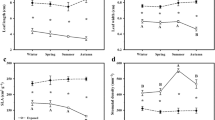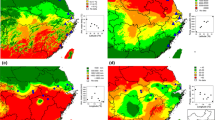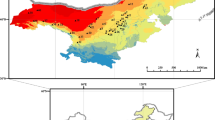Abstract
Every species is limited both geographically and ecologically to a subset of available habitats, yet for many species the causes of distribution limits are unknown. Temperature is thought to be one of the primary determinants of species distributions along latitudinal and altitudinal gradients. This study examined leaf physiology and plant performance under contrasting temperature regimes of sister species of monkeyflower, Mimulus cardinalis and Mimulus lewisii (Phrymaceae), that differ in altitude distribution to test the hypothesis that temperature is the primary determinant of differences in fitness versus altitude. Each species attained greatest aboveground biomass, net photosynthetic rate, and effective quantum yield of photosystem II when grown under temperatures characteristic of the altitudinal range center. Although both species exhibited greater stem length, stomatal conductance, and intercellular CO2 concentration in hot than in cold temperatures, these traits showed much greater reductions under cold temperature for M. cardinalis than for M. lewisii. Survival of M. lewisii was also sensitive to temperature, showing a striking decrease in hot temperatures. Within each temperature regime, the species native to that temperature displayed greatest growth and leaf physiological capacity. Populations from the altitude range center and range margin of each species were used to examine population differentiation, but central and marginal populations did not differ in most growth or leaf physiological responses to temperature. This study provides evidence that M. cardinalis and M. lewisii differ in survival, growth, and leaf physiology under temperature regimes characterizing their contrasting low and high altitude range centers, and suggests that the species’ altitude range limits may arise, in part, due to metabolic limitations on growth that ultimately decrease survival and limit reproduction.


Similar content being viewed by others
References
Ackerly DD et al. (2000) The evolution of plant ecophysiological traits: recent advances and future directions. Bioscience 50:979–995
Angert AL (2005) The ecology and evolution of elevation range limits in monkeyflowers. In: Plant biology. Michigan State University, East Lansing, Mich.
Angert AL, Schemske DW (2005) The evolution of species’ distributions: reciprocal transplants across the elevation ranges of Mimulus cardinalis and M. lewisii. Evolution 59:222–235
Anthony KRN, Connolly SR (2004) Environmental limits to growth: physiological niche boundaries of corals along turbidity–light gradients. Oecologia 141:373–384
Antonovics J (1976) The nature of limits to natural selection. Ann Mo Bot Gard 63:224–247
Arntz AM, DeLucia EH, Jordan N (1998) Contribution of photosynthetic rate to growth and reproduction in Amaranthus hybridus. Oecologia 117:323–330
Beardsley PM, Yen A, Olmstead RG (2003) AFLP phylogeny of Mimulus section Erythranthe and the evolution of hummingbird pollination. Evolution 57:1397–1410
Bolhar-Nordenkampf HR, Öquist G (1993) Chlorophyll fluorescence as a tool in photosynthesis research. In: Hall DO, Scurlock JMO, Bolhar-Nordenkampf HR, Leegood RC, Long SP (eds) Photosynthesis and production in a changing environment: a field and laboratory manual. Chapman and Hall, London, pp 193–206
Bongi G, Long SP (1987) Light dependent damage to photosynthesis in olive leaves during chilling and high temperature stress. Plant Cell Environ 10:241–249
Cline MG, Agatep AO (1970) Temperature and photoperiodic control of developmental responses in climatic races of Mimulus. Plant Cell Physiol 11:609–619
Close DC, Beadle CL (2003) Chilling-dependent photoinhibition, nutrition and growth analysis of Eucalyptus nitens seedlings during establishment. Tree Physiol 23:217–226
Cossins AR, Bowler K (1987) Temperature biology of animals. Chapman and Hall, London
Criddle RS, Hopkin MS, McArthur ED, Hansen LD (1994) Plant distribution and the temperature coefficient of metabolism. Plant Cell Environ 17:233–243
Cunningham SC, Read J (2002) Comparison of temperate and tropical rainforest tree species: photosynthetic responses to growth temperature. Oecologia 133:112–119
Falk S, Maxwell DP, Laudenbach DE, Huner NPA (1996) Photosynthetic adjustment to temperature. In: Baker NR (ed) Photosynthesis and the environment, vol 5. Kluwer, Dordrecht, pp 367–385
Faugeron S, Martinez EA, Correa JA, Cardenas L, Destombe C, Valero M (2004) Reduced genetic diversity and increased population differentiation in peripheral and overharvested populations of Gigartina skottsbergii (Rhodophyta, Gigartinales) in southern Chile. J Phycol 40:454–462
Ferris R, Nijs I, Behaeghe T, Impens I (1996) Elevated CO2 and temperature have different effects on leaf anatomy of perennial ryegrass in spring and summer. Ann Bot 78:489–497
Grace J (1987) Climatic tolerance and the distribution of plants. New Phytol 106:113–130
Graves JD, Taylor K (1986) A comparative study of Geum rivale L. and G. urbanum L. to determine those factors controlling their altitudinal distribution. I. Growth in controlled and natural environments. New Phytol 104:681–691
Graves JD, Taylor K (1988) A comparative study of Geum rivale L. and G. urbanum L. to determine those factors controlling their altitudinal distribution. II. Photosynthesis and respiration. New Phytol 108:297–304
Haldimann P, Feller U (2004) Inhibition of photosynthesis by high temperature in oak (Quercus pubescens L.) leaves grown under natural conditions closely correlates with a reversible heat-dependent reduction of the activation state of ribulose-1,5-bisphosphate carboxylase/oxygenase. Plant Cell Environ 27:1169–1183
Heller HG, Gates DM (1971) Altitudinal zonation of chipmunks (Eutamias): energy budgets. Ecology 52:424–433
Hickman JC (ed) (1993) The Jepson manual: higher plants of California. University of California Press, Berkeley, Calif.
Hiesey WM, Nobs MA, Björkman O (1971) Experimental studies on the nature of species. V. Biosystematics, genetics, and physiological ecology of the Erythranthe section of Mimulus. Carnegie Institute of Washington publication no. 628. Carnegie Institute, Washington, D.C.
Holt RD, Keitt TH (2005) Species’ borders: a unifying theme in ecology. Oikos 108:3–6
Holt RD, Keitt TH, Lewis MA, Maurer BA, Taper ML (2005) Theoretical models of species’ borders: single species approaches. Oikos 108:18–27
Hughes L (2000) Biological consequences of global warming: is the signal already apparent? Trends Ecol Evol 15:56–61
Huner NPA, Migus W, Tollenaar M (1986) Leaf CO2 exchange rates in winter rye grown at cold-hardening and nonhardening temperatures. Can J Plant Sci 66:443–452
Huntley B (1991) How plants respond to climate change—migration rates, individualism and the consequences for plant communities. Ann Bot 67:15–22
Hurry VM, Huner NPA (1991) Low growth temperature affects a differential inhibition of photosynthesis in spring and winter wheat. Plant Physiol 96:491–497
Iio A, Fukasawa H, Nose Y, Kakubari Y (2004) Stomatal closure induced by high vapor pressure deficit limited midday photosynthesis at the canopy top of Fagus crenata Blume on Naeba mountain in Japan. Trees Struct Funct 18:510–517
Jarvinen A, Vaisanen RA (1984) Reproduction of Pied Flycatchers (Ficedula hypoleuca) in good and bad breeding seasons in a northern marginal area. Auk 101:439–450
Kao WY, Tsai TT, Chen WH (1998) A comparative study of Miscanthus floridulus (Labill) Warb and M. transmorrisonensis Hayata: photosynthetic gas exchange, leaf characteristics and growth in controlled environments. Ann Bot 81:295–299
Kimura MT (2004) Cold and heat tolerance of drosophilid flies with reference to their latitudinal distributions. Oecologia 140:442–449
Kirkpatrick M, Barton NH (1997) Evolution of a species range. Am Nat 150:1–23
Laisk A, Rasulov BH, Loreto F (1998) Thermoinhibition of photosynthesis as analyzed by gas exchange and chlorophyll fluorescence. Russ J Plant Physiol 45:412–421
Leegood RC, Edwards GE (1996) Carbon metabolism and photorespiration: temperature dependence in relation to other environmental factors. In: Baker NR (ed) Photosynthesis and the environment, vol 5. Kluwer, Dordrecht, pp 191–221
Lesica P, Allendorf FW (1995) When are peripheral populations valuable for conservation? Conserv Biol 9:753–760
Llorens L, Peñuelas J, Beier C, Emmett B, Estiarte M, Tietema A (2004) Effects of an experimental increase of temperature and drought on the photosynthetic performance of two ericaceous shrub species along a north-south European gradient. Ecosystems 7:613–624
Loik ME, Nobel PS (1993) Freezing tolerance and water relations of Opuntia fragilis from Canada and the United States. Ecology 74:1722–1732
MacArthur RH (1972) Geographical ecology: patterns in the distribution of species. Harper and Row, New York
Mächler F, Nösberger J (1977) Effect of light intensity and temperature on apparent photosynthesis of altitudinal ecotypes of Trifolium repens L. Oecologia 31:73–78
Mariko S, Koizumi H, Suzuki J-I, Furukawa A (1993) Altitudinal variations in germination and growth responses of Reynoutria japonica populations on Mt. Fuji to a controlled thermal environment. Ecol Res 8:27–34
Martin B, Ort DR (1985) The recovery of photosynthesis in tomato subsequent to chilling exposure. Photosynth Res 6:121–132
Matzner S, Comstock J (2001) The temperature dependence of shoot hydraulic resistance: implications for stomatal behaviour and hydraulic limitation. Plant Cell Environ 24:1299–1307
McNab BK (1973) Energetics and the distribution of vampires. J Mammal 54:131–143
Medail F, et al. (2002) Comparative analysis of biological and ecological differentiation of Anemone palmata L. (Ranunculaceae) in the western Mediterranean (France and Spain): an assessment of rarity and population persistence. Bot J Linn Soc 140:95–114
Mehlman DW (1997) Change in avian abundance across the geographic range in response to environmental change. Ecol Appl 7:614–624
Molenaar FJ, Breeman AM (1994) Ecotypic variation in Phyllophora pseudoceranoides (Rhodophyta) ensures winter reproduction throughout its geographic range. J Phycol 30:392–402
Monson RK (1996) The use of phylogenetic perspective in comparative plant physiology and developmental biology. Ann Mo Bot Gard 83:3–16
Naidu SL, Long SP (2004) Potential mechanisms of low-temperature tolerance of C4 photosynthesis in Miscanthus×giganteus: an in vivo analysis. Planta 220:145–155
Nelson CJ (1988) Genetic associations between photosynthetic characteristics and yield: review of the evidence. Plant Physiol Biochem 26:543–554
Olmsted I, Dunevitz H, Platt WJ (1993) Effects of freezes on tropical trees in Everglades National Park, Florida, USA. Trop Ecol 34:17–34
Orfanidis S (1993) Temperature responses and distribution of several Mediterranean macroalgae belonging to different distribution groups. Bot Mar 36:359–370
Owens TG (1994) In vivo chlorophyll fluorescence as a probe of photosynthetic physiology. In: Alscher R, Wellburn A (eds) Plant responses to the gaseous environment. Chapman and Hall, London, pp 195–217
Parmesan C, et al. (1999) Poleward shifts in geographical ranges of butterfly species associated with regional warming. Nature 399:579–583
Perez-Tris J, Carbonell R, Telleria JL (2000) Abundance distribution, morphological variation and juvenile condition of robins, Erithacus rubecula (L.), in their Mediterranean range boundary. J Biogeogr 27:879–888
Pitterman J, Sage RF (2000) Photosynthetic performance at low temperature of Bouteloua gracilis Lag., a high-altitude C4 grass from the Rocky Mountains, USA. Plant Cell Environ 23:811–823
Pitterman J, Sage RF (2001) The response of the high altitude C4 grass Muhlenbergia montana (Nutt.) A. S. Hitchc. to long- and short-term chilling. J Exp Bot 52:829–838
Poorter H, Remkes C, Lambers H (1990) Carbon and nitrogen economy of 24 wild-species differing in relative growth-rate. Plant Physiol 94:621–627
Root T (1988) Environmental factors associated with avian distributional boundaries. J Biogeogr 15:489–505
Sack L, Melcher PJ, Zwieniecki MA, Holbrook NM (2002) The hydraulic conductance of the angiosperm leaf lamina: a comparison of three measurement methods. J Exp Bot 53:2177–2184
Sayed OH (2003) Chlorophyll fluorescence as a tool in cereal crop research. Photosynthetica 41:321–330
Scheidel U, Rohl S, Bruelheide H (2003) Altitudinal gradients of generalist and specialist herbivory on three montane Asteraceae. Acta Oecol 24:275–283
Schemske DW, Bradshaw HD (1999) Pollinator preference and the evolution of floral traits in monkeyflowers (Mimulus). Proc Natl Acad Sci USA 96:11910–11915
Schreiber U, Bilger W, Neubauer C (1994) Chlorophyll fluorescence as a nonintrusive indicator for rapid assessment of in vivo photosynthesis. In: Schulze E-D, Caldwell MM (eds) Ecophysiology of photosynthesis, vol 100. Springer, Berlin Heidelberg New York, pp 49–70
Sewell MA, Young CM (1999) Temperature limits to fertilization and early development in the tropical sea urchin Echinometra lucunter. J Exp Mar Biol Ecol 236:291–305
Silberbauer-Gottsberger I, Morawetz W, Gottsberger G (1977) Frost damage of cerrado plants in Botucatu, Brazil, as related to the geographical distribution of the species. Biotropica 9:253–261
Slatyer RO (1977) Altitudinal variation in the photosynthetic characteristics of snow gum, Eucalyptus pauciflora Sieb. ex Spreng. III. Temperature response of material grown in contrasting thermal environments. Aust J Plant Physiol 4:301–312
Thomas CD, et al. (2001) Ecological and evolutionary processes at expanding range margins. Nature 411:577–581
Tyree MT, Patino S, Bennink J, Alexander J (1995) Dynamic measurements of root hydraulic conductance using a high-pressure flowmeter in the laboratory and field. J Exp Bot 46:83–94
Van Rossum F, Vekemans X, Gratia E, Meerts P (2003) A comparative study of allozyme variation of peripheral and central populations of Silene nutans L. (Caryophyllaceae) from Western Europe: implications for conservation. Plant Syst Evol 242:49–61
Woodward FI (1975) The climatic control of the altitudinal distribution of Sedum rosea (L.) Scop. and S. telephium L. II. The analysis of plant growth in controlled environments. New Phytol 74:335–348
Woodward FI (1979) The differential temperature responses of the growth of certain plant species from different altitudes. I. Growth analysis of Phleum alpinum L., P. bertolonii D. C., Sesleria albicans Kit. and Dactylis glomerata L. New Phytol 82:385–395
Woodward FI (1990) The impact of low temperatures in controlling the geographical distribution of plants. Philos Trans R Soc Lond B Biol Sci 326:585–592
Woodward FI, Pigott CD (1975) The climatic control of the altitudinal distribution of Sedum rosea (L.) Scop. and S. telephium L. I. Field observations. New Phytol 74:323–334
Xiong FS, Ruhland CT, Day TA (1999) Photosynthetic temperature response of the Antarctic vascular plants Colobanthus quitensis and Deschampsia antarctica. Physiol Plant 106:276–286
Acknowledgements
I thank M. Bricker, D. Ellair, M. Hammond, and A. MacMillian for assistance with data collection and plant care. Financial support was provided by a National Science Foundation Graduate Research Fellowship. D. Ackerly, T. Bradshaw, J. Conner, K. Gross, H. Maherali, R. Monson, D. Schemske, and two anonymous reviewers provided many helpful comments on the manuscript.
Author information
Authors and Affiliations
Corresponding author
Additional information
Communicated by Robert Pearcy
Electronic supplementary material
Rights and permissions
About this article
Cite this article
Angert, A.L. Growth and leaf physiology of monkeyflowers with different altitude ranges. Oecologia 148, 183–194 (2006). https://doi.org/10.1007/s00442-006-0361-z
Received:
Accepted:
Published:
Issue Date:
DOI: https://doi.org/10.1007/s00442-006-0361-z




